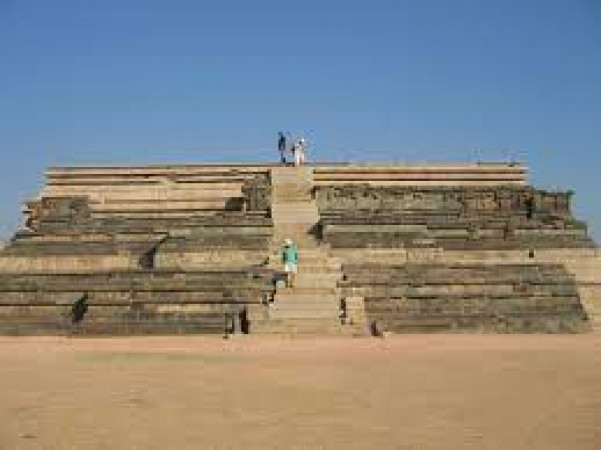Mahanavami Dibba Travel Guide
Mahanavami Dibba, located in India, is a historical site that holds great cultural significance. It served as a platform for the kings of the Vijayanagara Empire to celebrate the Navaratri festival. The intricate carvings and architectural marvels at Mahanavami Dibba offer a glimpse into the grandeur of the past. This destination is famous for its historical importance and stunning architectural beauty.Top Attractions in Mahanavami Dibba
- Exquisite carvings on the platform
- Views of the surrounding landscape
- Historical significance of the site
- Archaeological exploration opportunities
Mahanavami Dibba is Famous for
Its historical importance and architectural beauty.Top Attractions in Mahanavami Dibba
- Exquisite carvings on the platform
- Views of the surrounding landscape
- Historical significance of the site
- Archaeological exploration opportunities
What's Great about Travelling to Mahanavami Dibba?
- History enthusiasts
- Architectural buffs
- Cultural explorers
What's Not So Great about Travelling to Mahanavami Dibba?
- Not ideal for adventure seekers
- Limited recreational activities
- May not appeal to those seeking modern amenities
Travel Tips for Mahanavami Dibba
- Check visa requirements before traveling
- Book accommodations in advance
- Respect the historical significance of the site
Important Mahanavami Dibba trip information
- Ideal Duration: 1-2 days
- Best Time to Visit: October to March
- Nearby Airports and Railway Stations: The nearest airport is in Bangalore, and the nearest railway station is in Hospet.
FAQ's on Mahanavami Dibba
Q1: What is the best time to visit Mahanavami Dibba?
The best time to visit Mahanavami Dibba is during the winter months from October to March when the weather is pleasant and ideal for exploring the historical site. This period also coincides with the festival season, offering a chance to witness cultural events and celebrations.
Q2: Do I need a visa to travel to Mahanavami Dibba?
Travelers to Mahanavami Dibba may require a tourist visa depending on their nationality. It is advisable to check with the local embassy or consulate for specific visa requirements. Some countries may have visa exemptions or visa-on-arrival facilities for short visits.
Q3: What are the must-visit attractions in Mahanavami Dibba?
Mahanavami Dibba is known for its historical significance and top attractions include the impressive platform structure, the intricate carvings, and the surrounding archaeological sites like the Queen's Bath and the Royal Enclosure. Don't miss the chance to explore the ancient ruins and learn about the rich history of the region.
Q4: Is Mahanavami Dibba a safe place to travel?
Mahanavami Dibba is generally a safe place to travel, but like any destination, it is essential to take standard safety precautions. It is advisable to avoid isolated areas at night and be cautious of pickpocketing in crowded places. Travelers are encouraged to stay informed about local conditions and follow any travel advisories.
Q5: What is the local currency in Mahanavami Dibba and can I use credit cards?
The local currency in Mahanavami Dibba is the Rupee. While credit cards are accepted in some hotels and larger establishments, it is recommended to carry cash for smaller purchases and in more remote areas. ATMs are available in major towns for convenient access to money.
Q6: What is the local cuisine like in Mahanavami Dibba?
The local cuisine in Mahanavami Dibba offers a variety of flavors and dishes, including traditional South Indian fare like dosas, idlis, and sambar. Seafood is also popular due to the region's coastal location. Vegetarian options are widely available, and visitors can enjoy a mix of spicy and savory flavors unique to the area.
Q7: What transportation options are available in Mahanavami Dibba?
Transportation options in Mahanavami Dibba include public buses, auto-rickshaws, and taxis for getting around locally. Rental cars or bikes are also available for those who prefer more flexibility in their travels. Guided tours are a great way to explore the area and learn about its history.
Q8: Are there any cultural norms or etiquette I should be aware of when visiting Mahanavami Dibba?
When visiting Mahanavami Dibba, it is important to respect local customs and traditions. Dress modestly when visiting religious sites, remove your shoes before entering temples, and ask for permission before taking photos of people. Greeting locals with a is appreciated, and it is customary to use your right hand for eating and giving/receiving items.
Q9: I am a travel agent. How can I buy travel leads of Mahanavami Dibba?
Register yourself as a travel agent at agents.tripclap.com and then you can buy travel leads to Mahanavami Dibba once your account is approved. For more details contact our support team at +91-8069186564 or support@tripclap.com

